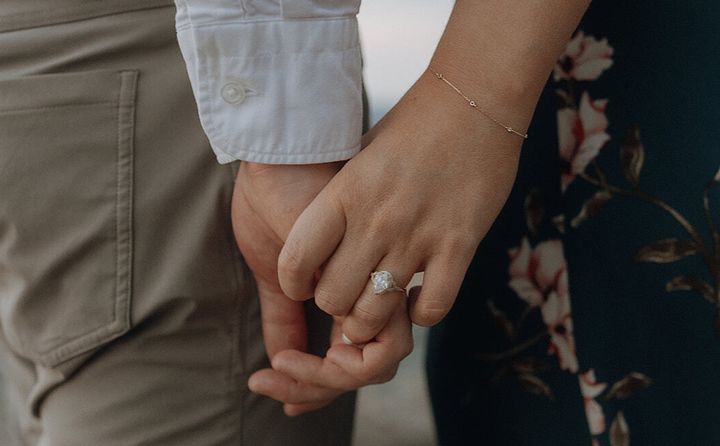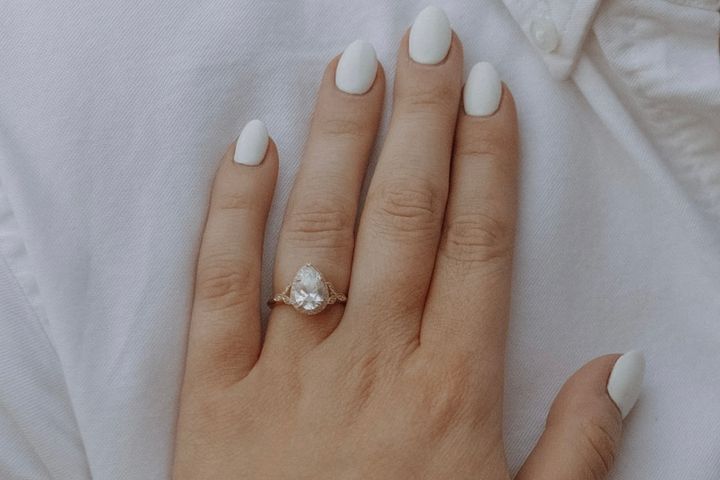
The other day I was in an elevator and a woman pointed at my hand. “That’s a beautiful engagement ring,” she said.
“Thanks,” I replied. “I picked it.”
She smiled and said, “Good for you,” just as the doors opened and she exited the lift.
When I say I chose my ring, I don’t mean that I sent preferences to my sister, who relayed them to my boyfriend, who did his best to find something that fit my style. My boyfriend and I went to a store together and chose something we both liked, which he purchased and kept for a few weeks until he officially proposed.
I imagined that telling people I chose my own engagement ring would go something like the encounter with the stranger in the elevator. I thought everyone would respond with a similar positivity. Many of them did. But peppered in was a different sort of response: looks of ”Oh, that’s interesting” and a quick change of subject. I never experienced outright criticism; it was more a feeling that the person was a bit taken aback, and not in the best way.
I never acknowledged these reactions, not wanting to bring any negativity into my post-engagement love bubble. But months later, after things settled down, those responses stayed with me, less because they bothered me and more because I couldn’t understand them. Were they judging me? And why?
For my then-boyfriend and I, selecting a ring together just made sense. We’d been in a relationship for nearly seven years and living together for four, so there wasn’t a ton of surprise in the fact that we were headed toward marriage.
Then, take into account our personalities. I’m picky and can be very opinionated. I’m also a fashion editor, so I can’t help but put an excessive amount of thought into everything I wear. My partner, on the other hand, is very go-with-the-flow. He tends to be a little indecisive. Selecting an expensive piece of jewellery is precisely the type of activity that would thrill me and overwhelm him.
Modern weddings and the events surrounding them break from tradition and historic gender roles in so many ways. And for many couples headed toward marriage, the fact that an engagement is coming isn’t a surprise — they’ve talked about it to some extent. If you’re discussing getting engaged, why not talk about the ring, too? Why should there be any shame in wanting a say in a (very expensive) piece of jewellery you’re supposed to wear for the rest of your existence?
“Over 75% of couples involve their partner in some part of the buying process.”
- Don O’Connell, president & CEO of Charles & Colvard
I put a callout on social media to see if anyone else in my orbit had had a similar experience. “I never really understood the whole thing of telling your sister exactly what you want so she can make sure your boyfriend picks a good ring,” said Grace Runowski, 32, of Mantua, New Jersey. “Why not just do that together, as the two people entering into a marriage?”
For Runowski, it also came down to a practicality. “I do not trust my husband’s style,” she said. And for her, the process didn’t detract from the big day. “The proposal itself was still a surprise and romantic and special. It could have been ruined by a bad ring because I’m a terrible liar and he obviously knows me well enough to tell if I don’t like something and am trying to pretend.”
Still, she faced judgment for the decision. “Some people seemed truly shocked that I picked my own ring,” she shared, adding, “I don’t really remember anyone older than me loving the idea.”
“Some people definitely didn’t understand, but I was never bothered by it because it was what I wanted, and it worked for us. About as often as people seemed to judge, women would respond with something like, ‘Hell yeah, girl,’” Runowski concluded.
Conversely, my cousin Danit Ergas shared that she wasn’t initially over the moon about the ring her husband chose, and she regretted not being more involved in the selection process.
“It is better to decide or talk about it together,” the 34-year-old, who lives in Austin, Texas, said of selecting a ring. “It will be with you for the rest of your life.” Although she now loves her “unique” ring, she and her husband decided to make a point of asking each other for specific wishes regarding gifts moving forward: “It’s convenient.”

Suspense is lost, but certainty is gained.
The concept that the ring recipient should be thrilled with whatever they receive doesn’t make sense to me. In all other situations, we reject the idea that one partner should control what the other wears — and this is an item the recipient is intended to wear virtually every day for the rest of their lives. Shouldn’t the giver want to know with complete certainty that their partner would want to do so?
To be clear, I do understand that many people love the element of surprise, whether it’s having no clue what the ring will look like or passing along hints and hoping for the best. What I don’t understand is that it’s the presumed default. Wouldn’t just as many of us want no surprise at all as those who do? So why don’t people talk about it?
This idea made me curious about exactly how common the joint approach is. Don O’Connell, who has been in the jewellery industry for over 30 years and now serves as the president and CEO of Charles & Colvard, shared that, in his experience, “over 75% of couples involve their partner in some part of the buying process,” whether by shopping together or sharing information, and that “in recent years we have seen more couples who are jointly involved in the engagement and marital process from start to finish.”
While the “whisper down the valley” method of choosing can be successful, it also leaves room for error as descriptions get lost in translation. What looks “dainty” or “large” to one person may mean something entirely different to another.
“We find most people would prefer to receive their dream ring rather than be surprised with a ring they are not in love with,” O’Connell added.
I also spoke with Ariel Alexandrou, who works in sales and design at Ken & Dana Design (where we ended up getting our ring). Her estimate was even more staggering. She approximated that 70% of Ken & Dana’s engagement ring customers are couples who come into the showroom to shop together and “they will often purchase the ring with their partner present.” (Some couples opt to keep an element of surprise by letting the recipient select a few top choices and having the ring giver secretly choose one for purchase.)
Those numbers shocked me — not because the process doesn’t make sense, but because I never hear people talk about doing it.
Another thing to consider: People who try on their rings ahead of time often surprise themselves with what they end up liking best. Customers shopping for their own engagement ring come in with a particular style in mind, “and then when they see it on their hand, they may decide to go in a completely different direction,” Alexandrou said. “I also often experience clients trying on a stone shape that they think they’ve ruled out, and they end up loving it.”
It happened to me. What was my favorite ring on jeweller’s website did not end up being my favorite ring in person. And when I was torn between styles, it was helpful to have my partner there to give his input. One band I found interesting was quickly ruled out after my partner admitted he didn’t love the design. Easy. Go team.
Shopping together also gave us the opportunity to explore more distinctive styles than your typical solitaire, halo or pavé. I ended up gravitating toward a unique, vintage-inspired design with three little eyelets on either side of the centre stone. It’s one that I wasn’t sure I loved based on seeing it online, but when I put it on my finger, it felt right. And it’s one that my partner probably never would have landed on alone, nor would he have felt comfortable pulling the trigger on something so nontraditional without confirmation that I’d love it.
Surprise rings will always carry risk. Both Alexandrou and O’Connell have experienced customers coming back to their stores after a proposal because the chosen ring turned out not to be the recipient’s style. (So if you’re going the surprise route, “it is extremely important to select your retailer or jeweller carefully, as some may not offer exchanges or returns,” O’Connell cautioned.) If you ask me, returning and exchanging your engagement ring after a proposal is a lot less romantic than talking about it ahead of time.
Rather than my then-boyfriend being on a solo mission and me constantly on edge about what might happen when, we were on a journey toward our engagement together. It took the pressure off both of us. We could just enjoy it. We were getting ready to make one of the biggest decisions of our lives, and we were doing it as a team. And when we finally decided on “the one,” we left feeling confident that we — together — had gotten the perfect ring.